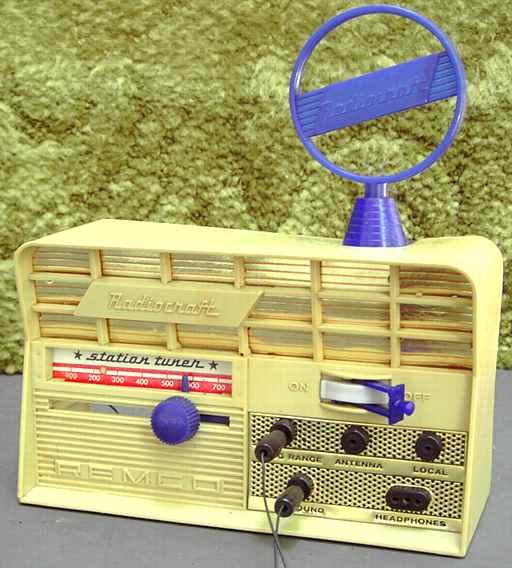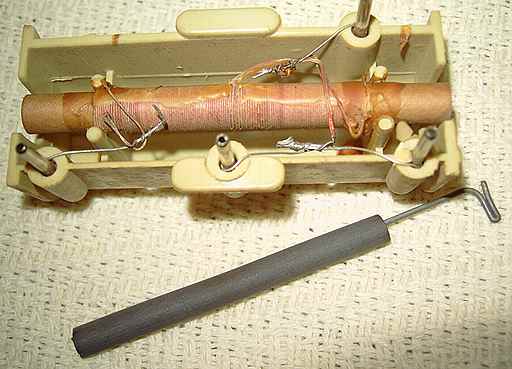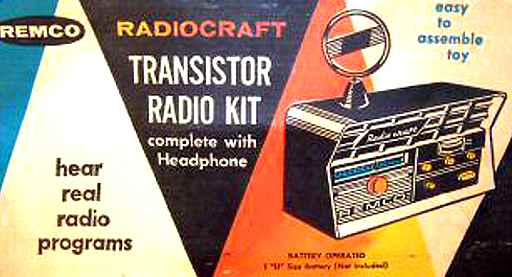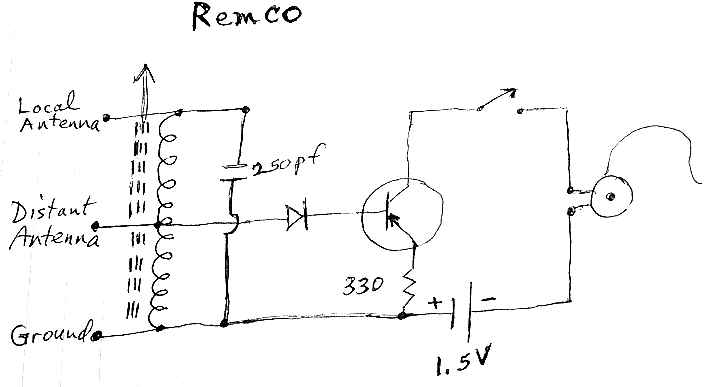
Remco Radiocraft toy radio
It certainly doesn't qualify as a boatanchor but many youthful experimenters started their radio involvement with one of these. Made by Remco Industries of Newark, New Jersey. Remco was one of the larger toy manufacturers in the 1950's and 60's but sought bankruptcy protection in 1971 and faded from the scene soon after. Its products included a number of scientific toys. This Remco Radiocraft is actually a crystal radio with a permeable coil for tuning and a single transistor as audio amplifier. I drew the schematic of the toy as found. See below.
My first radio was an earlier version of this Remco, just a germanium diode and a sliding contact coil. As a kid, I was eager to put up an antenna between a couple of trees. Much to my disappointment, that childhood Remco did not work at all. No matter what I did to it, it did not pick up any radio signals. That Remco is long gone.

I decided to try again with this one courtesy of Zane P. Thank you, Zane. With a bit more knowledge and a couple of good antennas, I thought I should have better luck with this Remco. It came with the same cheap antenna and ground wires as my original. The wires seem to be made from spring steel. As I recall, the actual antenna was made from the same springy wire with a couple of small plastic insulators. At least the wires were sturdy, not easily cut. This set did not come with the original single headphone. That was not a problem since I had several good headphones that were all better constructed and more sensitive than the original one as I remembered it.

After cleaning the Remco, I pulled the permeability tuner to fix a couple of intermittent connections. I have a good VOM for checking continuity, something I did not have as a child. The lead wires connecting to the permeability loop stick mounting pins are just simply pushed in the holes for the mounting pins. They did not fit well. I can see where a child might have some difficulty assembling and making good connections.
I measured the inductance of the coil in place with the ferrite at the extremes. The entire coil measured from 22 to 435 uH. The ground side to the tap measured 16 to 167 uH.
The diode was shorted. I replaced it with a good 1N34A. The unlabeled PNP transistor was in good condition. I repaired and cleaned the "D" cell battery connectors. I cleaned the power switch leaf contacts and adjusted them for good continuity.
After all this, I tried out the little set. With a pair of good Brandes high impedance headphones and using an 80 meter dipole antenna, I could hear several radio programs at once. I recognized several as being from the 49 meter shortwave band.

Trying again using the "Baldies"
I tried again the next day and picked up the "fifties" music of a local AM broadcast station again with the Brandes headphones. I then tried a pair of vintage Baldwin headphones. Baldwins are known for their quality and sensitivity. What a difference! This time, I was able to comfortably listen to the broadcast station. The Baldies were like adding an extra stage of amplification.
I can see why my first Remco did not work. I lived in a rural area, too far from radio stations. The Remco single headphone was less sensitive than the Brandes headphones which I bought later and used as a teenager with a Heathkit AR-3. And they were not even close to the sensitivity of the Baldwins.
The toy was "guaranteed to work". I assume Remco could demonstrate the toy actually working at their headquarters. Remco was located in Newark, New Jersey, which is not far from the antennas of the 50 Kilowatt New York City stations. I grew up in a rural area, not close to any local broadcast station.
Other connections and "antennas"
I found the best reception was connecting the ground wire to the "local" antenna terminal and the antenna to the "distant" antenna terminal. My best antenna for broadcast reception was a vertical 5/8 wave for the 6 meter ham band. With those connections and the sensitive "Baldies", I could also listen comfortably with just the diode. I removed the battery and connected a clip lead between what was the battery negative terminal and the local antenna terminal.
I had heard about using the telephone "finger stop" on the old dial phones as an antenna. Not having an old dial phone with a metal finger stop, I used a small ceramic capacitor in series with the non-active wire in a 10 feet long RJ-11 phone extension. It runs parallel to the two active wires and I assumed that capacitive pickup would work. As an antenna, it worked almost as well as my 6 meter vertical on broadcast reception. (Be careful if you try this with a phone line. The active wires on phones carry voltages that will shock you. Hook up a little ceramic cap on an extension before plugging in the phone jack. Get help if you don't have expertise here.) Too bad I didn't have the "Baldies" and some knowledgeable adult guidance as a kid.
It was fun to revisit an electronic toy from my childhood with the skills and insight of an adult. My poor experiences with the Remco crystal set may have been unique. Let me know if you had better luck.
Comments from other Remco users
From GH
"That brought back a lot of memories. I had one in Montreal and it worked quite well. Of course we were near a lot of 50 kW stations. I remember using the finger stop. That was a great antenna for me. As I remember, mine was red."
From KC2EEB
"Thank you for such a wonderful website. The Remco radio brought back great memories. Mine didn't work either and I was in NYC."
From WB2BQY
"Great site! I loved the Remco Radiocraft one transistor radio you show on your site as a child. Mine picked up the local AM station on 1440 Khz for years as I listened on the one ear headphone supplied. The battery would last forever. Volume was quite high and I used to turn it down by detuning the ferrite bar slider."
From K4CWQ, (and an interesting twist in reception!)
"I was in a mountainous area, but my Remco kit did pick up a ham operator in my town. That was what first got me interested in ham radio. So it turned out to be a great Christmas toy."
From John
"No, you were not the only person to have bad luck with it. I bought one on ebay 2 years ago in hopes of making it work,I will take your notes and try again over my Christmas break... could never get my original one to work though."
From KE8SL
"Too bad your Remco kit didn't work for you. I got one as a Christmas gift as a kid and mine worked well enough that I could tune in to a few of the more powerful AM signals.
It was my introduction to communication hardware and probably one of the reasons I work as a datacom specialist today."
From WB7WQK
"I have remco one transistor crystal radio I think the model is 107. Saw your page but I would like a copy of the manual if some one has one to copy. I have a 106 without the amp that is louder. I checked the transistor and diode, both are good also. I used the same headphones. Thanks John 360-428-5995"

The RME VHF-152A converter was the previous item on the bench.